Few purchases are as fraught as a diamond engagement ring. Frequently the most expensive accessory we ever buy, engagement rings carry the totemic weight of representing one’s love and commitment, and are meant to be timeless in their perfection as we gaze upon them forevermore. And yet, although the sellers of those diamond rings can rhapsodize endlessly over a ring’s design and the cut, clarity, color, and carat size of the rock inside it, it’s rare that they disclose that diamond’s origins. This despite the relatively common knowledge that diamonds have helped finance unspeakable violence in war-torn countries, lined the pockets of corrupt billionaires, and wreaked environmental havoc all over the world.
[Quartz] Would you propose with a diamond grown in a lab?
It was a grey afternoon in February when I gave Martin his diamond back. He was already waiting at a window-side table at the Gramercy Park Hotel when I arrived. It felt like it could snow at any second, but he was suntanned, just back from the British Virgin Islands. He wasn’t wearing his glasses.
“Before I forget,” I said, taking the diamond out of the burgundy velveteen pouch I’d been carrying in my purse.
“Thanks,” he said. He tucked it into his wallet without looking at it.
I’d be lying if I said I’ve never imagined my engagement ring. My picture of the metal, the setting, the style—even the man offering it—has changed throughout the years, but aside from a brief dalliance with emeralds, the stone has remained the same: a white diamond.
Continue reading “[Quartz] Would you propose with a diamond grown in a lab?”
[BDI] 2015 for Global Diamond Industry – A Collection of Articles on Major Events that shaped the industry
Lab-grown diamonds: More acceptance, more success
Meanwhile, Lab-grown diamond sector is meeting with more acceptance among consumers and retailers alike. More jewelry retailers are now selling Lab-grown diamonds. Scio Diamond Technology – a major Lab-grown diamond producer, is now selling its diamonds at US’s 4th largest jewelry retailer – Helzberg Diamonds. Scio has also collaborated with Renaissance Diamonds Inc., which cuts & polishes diamonds, to sell its polished Lab-grown diamonds to jewelry retailers through a JV – Renaissance Created Diamonds. (See ‘Jewelry retailers are increasingly selling Lab- grown Diamonds’, Pg. 57)
[Bloomberg] Want to Make a Diamond in Just 10 Weeks? Use a Microwave
Microwaved stones—no dirty mines or bloody conflicts—might be a girl’s next-best friend
The 2.62-carat diamond Calvin Mills bought his fiancée in November is a stunner. Pear-shaped and canary-yellow, the gem cost $22,000. A bargain. Mills, the chief executive officer of CMC Technology Consulting in Baton Rouge, La., says he could have spent tens of thousands more on a comparably sized diamond mined out of the earth, but his came from a lab. “I got more diamond for less money,” says the former Southern University football player, who proposed last year at halftime during one of his alma mater’s games at the Superdome in New Orleans.
While man-made gems make up just a fraction of the $80 billion global diamond market, demand is increasing as buyers look for stones that are cheaper—and free of ethical taint. Human-rights groups, with help from Hollywood, have popularized the term “blood diamonds” to call attention to the role diamond mining has played in fueling conflicts in Africa.
Continue reading “[Bloomberg] Want to Make a Diamond in Just 10 Weeks? Use a Microwave”
[Polygon] Rise of the Synthetic Stone: A Polygon Industry Report
INTRODUCTION
On March 15, 2015, the world’s largest diamond ‘greenhouse’ opened for business in Singapore.
Owned and operated by IIa Technologies, the facility is a sprawling testament to the potential of disruptive innovation. Located in an industrial area of Singapore, the complex spans 200,000 square feet; inside, around 200 state-of-the-art machines produce Type IIa diamonds around the clock using the Microwave Plasma Chemical Vapor Deposition (MPCVD) method.
Continue reading “[Polygon] Rise of the Synthetic Stone: A Polygon Industry Report”
[IGI] LABORATORY GROWN DIAMOND REPORT
Synthetic diamonds, also referred to as “man-made” “lab-grown” or “created” diamonds, are diamonds manufactured in a laboratory— as opposed to natural diamonds, which form naturally within the Earth.
The acute shortage of industrial quality diamonds, mainly used in a variety of industrial applications, has been improved in part by the advent of synthetic diamonds. These have been manufactured by a range of different technological processes for over half a century. However, in recent years it has become technologically possible to produce gem-quality synthetic diamonds of commercially significant size and weight.
[Frost & Sullivan] Grown Diamonds Key to Unlocking Future for Diamond Industry
Grown Diamonds can help overcome the widening supply demand gap in the long run to compensate for falling mined diamonds supply
MOUNTAIN VIEW, Calif. – Jan. 15, 2015 – The mined diamond supply has seen a constant decline in the past decade driven by the fact that key diamond mines have passed their peak production levels. Moreover, the diamond mining process has become tougher as the mines age and new mines that are discovered often have shorter life spans and tougher mining conditions. This occurs in light of the rising demand from various markets such as the US, India and China which is likely to widen the demand and supply gap.
New analysis from Frost & Sullivan, Grown Diamonds – Unlocking Future of Diamond Industry by 2050 indicates how Grown Diamonds can represent a potential solution to the issue of global shortage of rough diamond supplies. The breakthrough in technology has made it possible to grow rare quality colorless IIa quality diamonds by creating diamond-growing conditions in semiconductor grade facilities, above the earth’s surface.
Continue reading “[Frost & Sullivan] Grown Diamonds Key to Unlocking Future for Diamond Industry”







